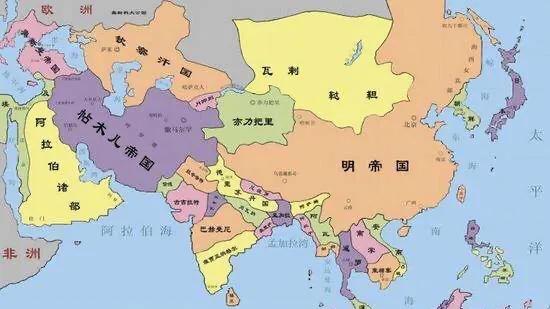In the impression of some netizens, the southernmost rule of the Ming and Qing dynasties is the most in the current North Vietnamese region.
To the south, the Ming and Qing dynasties in the Laos-Laos-Indonesia region of Myanmar were not involved, the sunshine is abundant, the rainfall is also very abundant, especially suitable for farming, China is also a large agricultural country, why did the dynasties rarely expand to the south?

Xinjiang and Tibet were relatively barren and sparsely populated, so why had the Central Plains Dynasty been keen to expand its territory to the West and neglected the southern regions?
In fact, it is not that the dynasties have ignored the southern region, but because the southern region is too far away from the Central Plains Dynasty, there is a feeling that the whip is beyond reach.
The southernmost rule of the Ming Dynasty actually reached the current Indonesia, but it did not set foot in this area during the Qing Dynasty.
I. Why did the Ming Dynasty not expand its territory?
In fact, the Ming Dynasty has always maintained a state of expansion to the south, but at that time, the overall north-south front of the Ming Dynasty was too far apart, although the Ming Dynasty eliminated the Yuan Dynasty, but the Northern Yuan government has always existed after the fall of the Northern Yuan, there are still nomadic peoples formed by Mongolian tribes invading the north.
Therefore, when Zhu Di was emperor, the whole country moved north, and made the ancestral precepts, the son of heaven guarding the gate of the country, and the requirements of the king's death. Therefore, the military strength of the Ming Dynasty Beijing clique was mainly focused on resisting the invasion of nomadic peoples, and the rule of the south was mainly a team composed of people and horses in Nanjing.
Although the land in the south was fertile, it also faced high mountain obstacles, and the most important military forces of the Central Plains Dynasty at that time were infantry and cavalry.
It takes too long for infantry to reach such a long distance, the supply of food and grass is very difficult, and the cavalry is difficult to cross in the face of these high mountains, so it is not realistic to completely conquer the small southern countries.
However, at that time, the princes and small states here were very aware of the times, and when they saw the strength of the Ming Army, they bowed down to the Ming Dynasty and accepted the Ming Dynasty's canonization.
Because the rule of Yunnan was relatively stable during the Ming Dynasty, Yunnan was used as a springboard to form a circle of influence of a vassal state in Southeast Asia.
At that time, southeast Asian countries had already claimed to the Ming Dynasty and expressed their willingness to pay tribute every year, and the Ming Dynasty set up the three Xuanfu and Six Consolation Systems (three Xuanfu Divisions and Six Xuanfu Divisions) in order to facilitate reasonable taxation here.
In the far south, sumatra, the Old Port Propaganda Division was set up in the current Old Port City of Sumendara, which already belonged to Indonesia, and the Propaganda Division here was ruled by the officials of the Central Plains sect in the past, and later took over in a hereditary manner. Nominally a minor official of the Ming Dynasty, he was actually equivalent to the local Emperor Taishang.
In the last years of the Ming Dynasty, due to the chaotic government of the country, all parts of Southeast Asia became independent and established their own small states.
Second, why did not expand the Qing Dynasty
During the Qing Dynasty, because foreign nationalities entered the Central Plains, their own military strength was relatively weak. After the establishment of the Qing Dynasty, it was mainly through the Han army to suppress the revolt of the domestic people.
At the beginning of the establishment of the Qing Dynasty, it was based on Manchu and Mongolian as a common basis to invade the Central Plains, so the Qing Dynasty focused more energy on the unification of all ethnic groups in Mongolia.
Therefore, he was often keen to pacify the circle of influence formed by the various ethnic groups in Mongolia and complete the regionalized rule of the Mongol nation, and these wars had already consumed a lot of the national strength of the Qing Dynasty.
Later, the Qing Dynasty also tried to expand to the southeast region, and after experiencing the Jinchuan Rebellion, the Qing Dynasty also realized that the people in the southeast region were fierce, after all, they had to pay a heavy price to win.
If the Qing Dynasty insisted on expanding to the southeast, it might drag down the entire Qing Dynasty, and the area ruled by the Qing Dynasty at that time was already large enough, so there was no need to expand south.